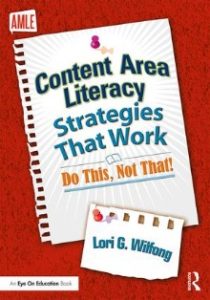Content Area Literacy Strategies That Work
Content Area Literacy Strategies That Work: Do This, Not That!
By Lori G. Wilfong
(Routledge/Eye On Education, 2019 – Learn more)

For any English as a Second Language teacher wanting to grow their English learners’ academic language in the core classrooms and to support core teachers, this book is for you!
My school is currently moving toward literacy-based instruction in all content areas, and Content Area Literacy Strategies that Work has so many ideas about how we can assist teachers in this transition.

In addition to these strategies, Lori G. Wilfong emphasizes the importance of explicitly teaching discipline-specific reading strategies, vocabulary strategies, and writing strategies in the content areas.
The Structure of the Book
Wilfong begins each section with a vignette to lead into the strategy and to explain how it benefits students. This presentation format makes it difficult for any literacy-in-the-content-area skeptic to ignore! Following the “Why” section are sections on how to get started, how to update instructional practices, and how to make Common Core connections.
I love the way Wilfong presents the sections on strategies, because she reminds teachers that each one is an “updated strategy” and not a completely new idea. I think this presentation is less intimidating for core teachers who do not view themselves as literacy teachers. Each chapter ends with a reflections section that encourages teachers to think about how they can use each recommended strategy in their classrooms.
The Content of the Book
Sections and Updated Strategies:
- Building Background Information Quickly
- Carousel Walk
- Wide Reading
- Technology to Reach and Teach
- Help Scaffold Focus While Reading with Specific Strategies
- Text Structures to Analyze and Organize Content
- Annotating Content Area Texts
- Explicitly Teaching How to Find and Generate Main Idea Statements
- Use Small Group Reading and Learning Strategies to Bring Personal Response and Accountability to the Content
- Textmasters (Literature Circle) to Facilitate Small Group Reading and Discussion
- Student Organized Learning Environments (S.O.L.E.)
- Address Discipline-Specific Content Reading Strategies
- Comparing Multiple Texts Using an I-Chart
- Placing the Mantle of the Expert on Students for Authentic Discussion
- Use Content Area Vocabulary in Meaningful Ways
- Using a Generative Approach to Building Vocabularies
- Moving from Memorization to Application
- Using Technology to Bring Vocabulary to Life
- Make Writing an Authentic Process in Every Classroom
- Set Ground Rules for Writing
- Use Graphic Organizers AFTER Drafting
- Think About What It Means to Be a Writer in Your Discipline
- Promote Daily Writing Strategies to Strengthen Thinking in the Discipline
- Using Entrance and Exit Slips
- Implementing Prompts and Quick Writes
- Learning Logs
- Implement Slightly Larger Weekly Writing Strategies to Encourage Comprehension and Synthesis in the Discipline
- CREW-C Arguments
- Bracket Battles
- Found Poetry
- Plan and Teach One “Big” Informational Piece Per Semester
- Applying Authentic Reasons and Formats for Informational Writing
- Meaningful Opportunities for Writing
- Fusing Narrative into Nonfiction
- Plan and Teach One “Big” Argumentative Piece Per Semester
- Finding Authentic Reasons for Argumentative Writing
- Creating Minilessons to Assist Students in Revision
- Flash Debates and Bracket Battles to Spur Argumentative Writing
Please refer to the following link to check out the online resource section to see a sampling of the goodies that you will find in the book: Content Area Literacy Strategies that Work eResources.
Recommended Audience
I would recommend this book to all literacy coaches and facilitators, ESL teachers, and content area teachers (and co-teachers) who want to grow students’ content area knowledge while also increasing their literacy skills.
In closing, I am currently using this book as a guideline to create a literacy-based ESL toolkit for my co-workers who teach Science and Social Studies. I should also note that I’m requesting multiple copies to be purchased for a faculty book study. If you want to use literacy-based instruction to teach core subjects, this book is a great resource to get moving quickly.
Jordan Walker-Reyes (@MrsWalkerReyes1) is an English as a Second Language teacher with a master’s degree in literacy and a bachelor’s degree in early childhood and elementary education. Her experience includes teaching in multiple states in the Southeastern United States in areas with high EL populations, including inner city and rural communities. She is currently teaching ESL in middle school while pursuing an Ed.D. in curriculum and instruction.


































